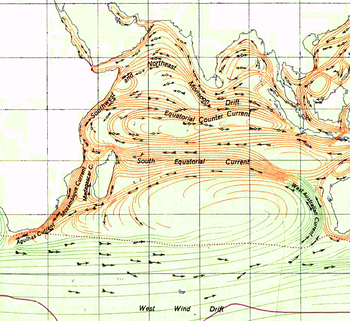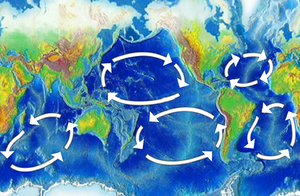Indian Ocean Gyre

The Indian Ocean gyre, located in the
global conveyor belt. The Indian Ocean gyre is composed of two major currents: the South Equatorial Current, and the West Australian Current
.
Normally moving counter-clockwise, in the winter the Indian Ocean gyre
Tibetan plateau, air pressure gradients over the Indian Ocean and the gyre are small. This results in winds of moderate strength, due to the protection from the full force winds blowing off the Mongolian high pressure region. Because of these moderate, dry winds, the Winter Monsoon season in the Indian Ocean region is the dry season for most of Southern Asia. Due to this seasonal wind cycle, the currents of the Indian Ocean, which make up the Indian Ocean gyre, are directly affected, causing reversal.[1]
Garbage patch
References
- ISBN 8170353068
- ^ "Ocean Geography ~ MarineBio Conservation Society". www.marinebio.org. 17 June 2018. Retrieved 2021-09-17.
- ^ First Voyage to South Atlantic Pollution Site SustainableBusiness.com News access-date=10 December 2021
- Yahoo, 27 July 2010
- ^ Opinion: Islands are 'natural nets' for plastic-choked seas Archived 6 October 2012 at the Wayback Machine Marcus Eriksen for CNN, Petroleum, CNN Tech 24 June 2010
- ^ Our Ocean Backyard: Exploring plastic seas Archived 20 June 2010 at the Wayback Machine, Dan Haifley, 15 May 2010, Santa Cruz Sentinel
- Times Live
- ^ Moore, Charles (November 2003). "Across the Pacific Ocean, plastics, plastics, everywhere". Natural History Magazine. Archived from the original on 2009-07-06.
- ^ Sesini, Marzia (August 2011). "The Garbage Patch In The Oceans: The Problem And Possible Solutions" (PDF). Columbia University.
- ^ "OSU: Reports of giant ocean 'garbage patch' are exaggerated". 4 January 2011. Archived from the original on 14 February 2011. Retrieved 7 January 2011.
- ^ Transoceanic Trash: International and United States Strategies for the Great Pacific Garbage Patch, Susan L. Dautel, 3 Golden Gate U. Envtl. L.J. 181 (2009)
External links
- Ocean currents Archived 2022-01-20 at the Wayback Machine


